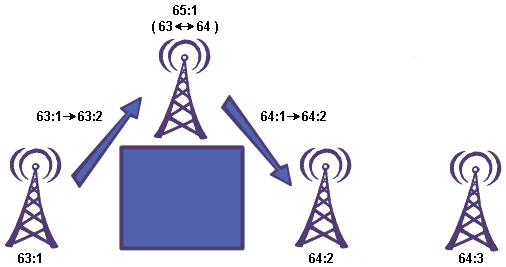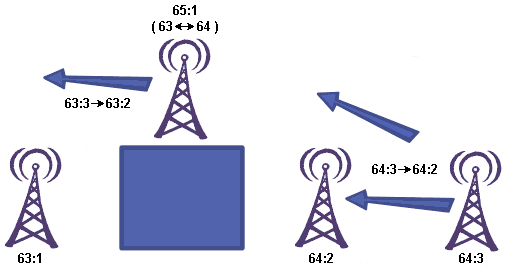Relays join two groups into one. It is important to take this into account when assigning location codes to your radios. Locations 63:10 and 64:10, for example, are effectively the same location if there is a relay in the system that connects groups 63 and 64.

Relay Mode
Any CDR XL family radio may be configured to act as a relay. When configured as a relay, the radio is programmed with two group numbers and is used to move data between these groups.
Example:
Suppose you have two groups of radios, a western group and an eastern group, that operate on opposite sides of a metal warehouse. The two groups need to communicate with each other, but the warehouse between them is blocking the signals and making communication between the groups unreliable.
To solve the problem, we can add a radio configured to act as a relay between the groups, and then position this relay on the warehouse's roof so it can get good line-of-sight visibility to both groups.
Relays connect any two group numbers, so for this example, let's arbitrarily assign the western group to 63 and the eastern group to 64. We have to use two different group numbers, as you will see down below. This makes sure that each cross-group transmission is heard only from the relay and not from the original transmitter as well. This prevents data duplication when the relay re-transmits the data.
Now imagine three radios, one in the western group (63:1) and two in the eastern group (64:2 and 64:3). Note how we did not assign location code 64:1 to either radio in the eastern group. The relay could also send and receive its own data, but for now, let's not assign it an address in either group. We'll give it location code 65:1.

Suppose radio 63:1 needs to send a message to 64:2. Instead of designating 64:2 as the message target, the western radio would address the message to 63:2. The relay would receive this message and rewrite the source and destination to indicate that the message came from 64:1 and is intended for 64:2. The relay would then retransmit the message from high above both sets of radios, and eastern radio 64:2 could now receive its data.
Note that the source and destination locations are both rewritten. This can be a little confusing in mixed-on mode when decoding a packet's source fields.
It's important that radios in a split group like this address their transmissions to their own group and allow the relay to do the translation between groups. This insures that the target radio does not receive the message twice if the relay is being used to "shore up" marginal communication between two groups of radios.

If radio 64:3 needs to send a message to radio 64:2, it can do so directly by setting the message's destination fields to 64:2. The relay will also try to forward this message to radio 63:2, but since there is no such radio, this relayed version of the message will be ignored by all.







